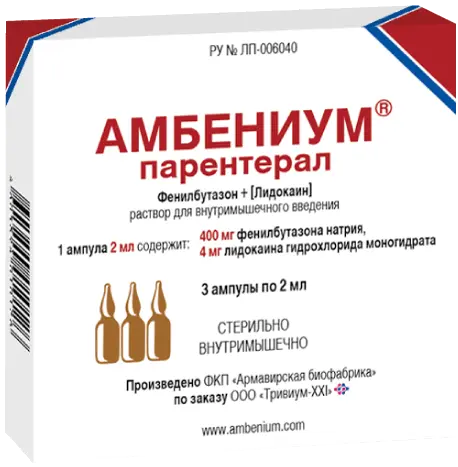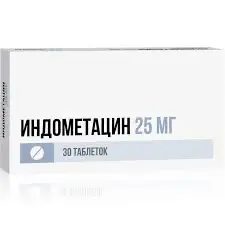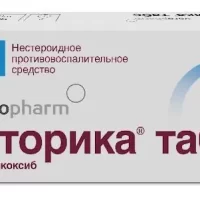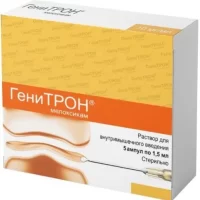Description
Ambenium Pharmacodynamics
Phenylbutazone has anti-inflammatory, analgesic, antipyretic effects. It indiscriminately inhibits the activity of cyclooxygenases (COX-1 and COX-2), disrupts arachidonic acid metabolism, and decreases the number of prostaglandins in the inflammation focus. Prostaglandins play an essential role in the development of the inflammatory reaction. Anti-inflammatory and analgesic effect of phenylbutazone reduces the severity of pain and inflammatory edema, morning stiffness, joint swelling, contributes to increased range of motion. Uricosuric effect of phenylbutazone is associated with reduction of tubular resorption of uric acid in kidneys.
Lidocaine hydrochloride has local anesthetic effect, blocks potential-dependent sodium channels, which prevents the generation of impulses in the endings of sensitive nerves and conduction of impulses along the nerve fibers. Suppresses the conduction of not only pain impulses, but also impulses of other modality. Reduces the pain effect during injection.
Indications
Symptomatic treatment of pain syndrome and inflammation in acute exacerbations:
– ankylosing spondylitis (Bechterew’s disease);
– rheumatoid arthritis;
– gout.
The drug is intended for symptomatic therapy, reduction of pain and inflammation at the time of use. It has no effect on disease progression.
The use of AMBENIUM® parenteral mainly should be made only in case when other therapeutic measures, including other non-steroidal anti-inflammatory drugs, have not produced sufficient analgesic effect.
Use of phenylbutazone in dose higher than recommended (373.4 mg) or additional use of other NSAIDs (except for acetylsalicylic acid in doses not exceeding 325 mg, used as anti-aggregant) does not provide additional analgesic effect, but significantly increases risk of adverse events and therefore is not recommended.
Contraindications
Hypersensitivity to phenylbutazone, lidocaine, amide type anesthetics or ancillary components of the drug;
– Severe cardiac conduction disorders, acute myocardial infarction during the period after coronary artery bypass grafting;
– decompensated heart failure;
– complete or incomplete combination of bronchial asthma, recurrent nasal and paranasal sinus polinosis, and intolerance to acetylsalicylic acid or other NSAIDs (including history);
– diseases of the blood and coagulation system (leukopenia, including a history, thrombocytopenia, hemophilia);
– active erosive-ulcerative lesions of the stomach or duodenum, or ulcerative disease of the stomach and duodenum, ulcerative colitis, Crohn’s disease;
– gastrointestinal bleeding, including in the anamnesis, provoked by taking NSAIDs;
– intracranial bleeding, acute cerebral circulatory disorders;
– renal or hepatic insufficiency;
– confirmed hyperkalemia;
– pregnancy, breast-feeding, children (under 18 years).
Caution
History of liver disease, hepatic porphyria, chronic heart failure, arterial hypertension, significant reduction in circulating blood volume (including after surgical intervention), elderly patients (including those who receive diuretics, weakened patients). diuretics, weakened patients and patients with low body weight); bronchial asthma; simultaneous use of glucocorticosteroids (including prednisolone), anticoagulants (including warfarin), antiplatelet agents (including acetylsalicylic acid, clopidogrel), selective serotonin reuptake inhibitors (including citalopram, citalopram, and corticosteroids), and selective serotonin reuptake inhibitors (including citric acid). including citalopram, fluoxetine, paroxetine, sertraline); coronary heart disease, cerebrovascular disease, dyslipidemia/hyperlipidemia, diabetes, peripheral arterial disease, smoking, Helicobacter pylori infection, long-term use of NSAIDs, thyroid disease, tuberculosis, alcoholism, severe medical conditions. Concomitant use with other NSAIDs, including COX-2 selective should be avoided.
Administration during pregnancy and breast-feeding
The safety of using this drug during pregnancy has not been proven. The effect of delayed prostaglandin synthesis on embryogenesis during the first two trimesters of pregnancy is unclear. In the last trimester of pregnancy, the mechanism of action of phenylbutazone is characterized by inhibition of labor activity, premature closure of Ductus arteriosus Botalli in fetus, increased susceptibility to bleeding in mother and child, increased risk of edema in mother.
Phenylbutazone penetrates into the mother’s milk in small amounts, and in case of breastfeeding phenylbutazone can be detected in the blood plasma of the infant.
Based on the above information, the drug is contraindicated during pregnancy and breastfeeding.
Dosage and administration method
- To decrease the risk of gastrointestinal side effects the lowest effective dose with the shortest possible course should be used.
- For treatment of acute conditions or relieving acute exacerbation of chronic disease the drug is administered once, slowly, deep into the muscle, in a dose of 373.4 mg (2 ml).
Daily dose: 373.4 mg (2 ml). The indicated dose should not be exceeded.
This dosage form should be used once. Further treatment should be given with phenylbutazone in tablet form if necessary, and all relevant instructions for use should be followed. - Because of the possible occurrence of anaphylactic reactions up to and including anaphylactic shock when using the drug, it is necessary to ensure the availability of a functional emergency care kit. The patient should be observed for at least 1 hour after administering the drug. The patient should be made aware of the importance of this measure.





